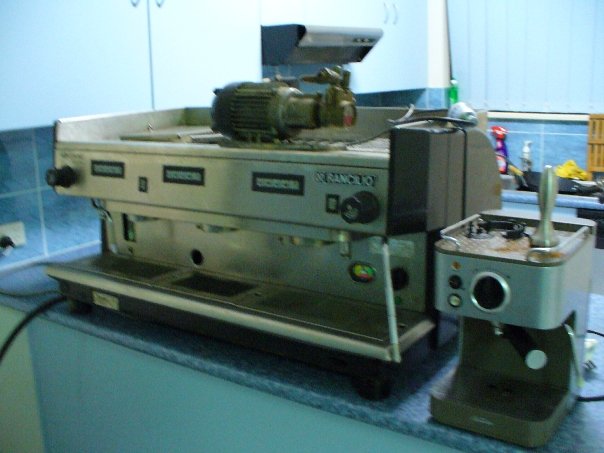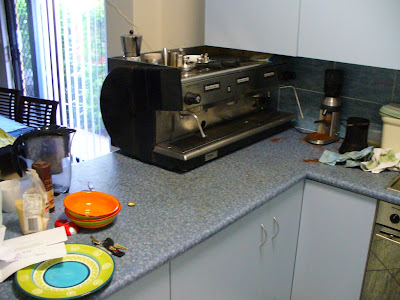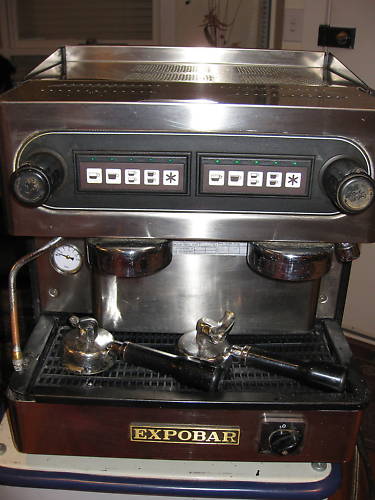This post is a response to a request on Twitter, but hopefully it’ll be a handy little resource for the long term…
There are lots of good reasons to ditch instant coffee at church morning teas – it tastes awful, it potentially reveals a shoddy doctrine of creation (and is one of the 7 deadly coffee sins), it’s (generally) less likely to be ethical, and doing coffee well is a chance to show your newcomers (and regulars) that you care about them.
Did you know that “no es cafe,” essentially nescafe means “is not coffee” in Spanish…
Anyway. Once you’ve decided to ditch the dirt from the church menu – you’re faced with a few conundrums.
Here are the three big questions (and some sub questions that’ll each send you in a different direction).
Some Questions
1. Who is it for? New people, or everyone? free? or paid? Covering costs? Making a profit?
2. What’s your budget? Are you going to buy a commercial machine with all the bells and whistles? lease one? Get a second hand ex-cafe machine on eBay? Get a giant percolator? And where are you going to get your beans? The supermarket (urgh)? A local roaster (mmm)? Roast your own? Will they be “ethical”? What program will you use (you know Fairtrade is stupid. Right?)
3. Who is going to run things? Who’ll man the machine? Who’ll do the training? Who’ll monitor supplies? Who’ll clean up?
Some Answers
The answers to these questions will depend largely on your church context – who your immediate mission field is and how many people you have who are able to help carry the load.
Here are some universal principles for answering these questions and providing good coffee at church – you can read more about these in my five steps to better coffee eBook for just $5… That’s right. $5.
1. Fresh coffee is best. Both roasted, and ground – that’s why I’d lean towards roasting your own, or getting into some sort of relationship with a roaster. You’ll probably need to buy a grinder, or, if you’re going the percolator route – get your coffee ground for your percolator as close to when you brew as possible.
2. Consistency is important. If you’re going to sell your coffee at church and you want to use the money to sustain a coffee ministry (in our case this happens at things like the playgroup that our building hosts during the week), then you want the product you’re offering to be trustworthy and good.
3. If you’re going to buy a second hand machine – choose carefully. I’ve now bought six used commercial machines on eBay for a 4-2 scoreline (priced between $270 and $750 excluding freight) – two were lemons (one was a lemon where the spare parts more than justified the cost), one needed pretty major work to get up and running.
4. If you go with a commercial espresso machine you have to think about incidental issues like electricity and water supply – some machines will happily draw from a tank (generally those with rotary motors), others might need plumbing in. Most will need 15A and above, power wise (the normal run of the mill socket is 10A).
5. Don’t make people pay. I’m a firm believer that hospitality is an important part of what we do on a Sunday both for the congregation and our guests. I’m not opposed to providing a “premium” option at a cost, if there’s a free option also.
A percolator using the right amount of fresh coffee, appropriately roasted, with attention paid to the brew cycle (where it isn’t left to stew for too long), will produce brilliant coffee with less fuss, less mess, and at a cheaper cost. So that is a more than adequate solution in most cases. But if you’d like something a little more high brow…
Two Case Studies
I’ve now set up Sheila (one of my pride and joys), my three group Rancilio Z-11 beast, at two different churches. Sheila, a tank (google Red V Blue, Season 1), is from an era when people knew how to make coffee machines. At one point I had rewired her to run on 10A power, but this meant she took 45 minutes to heat up. She’s now properly serviced, and running at full capacity on our coffee cart at Creek Road.

The first church, Clayfield Pressy, was a church of around 50 people, in a relatively high income pocket of Brisbane, there was just one morning service to cater for – it was a no brainer to make coffees for the 65% of the crowd who drink it, most weeks. I supplied the coffee at no cost (I roasted it myself), we had a small Sunbeam grinder, or I’d bring mine from home, and we upped the weekly milk order by two or three bottles.
Because the coffee was free, there was no need to provide an alternative option. I’d estimate I was going through about $5 worth of coffee a week, at cost (roasting for yourself is much cheaper – depending on the scale of your operation), and 8-10 litres of milk (I was also doing hot chocolates).
After I left, Clayfield purchased a relatively new Boema machine – they’re Australian made. I have no idea how often it gets used now.
Sheila came with me to Creek Road. For the first ten months or so of last year, she occupied pride of place in our Connect Lounge – the first port of call for newcomers at our church. We supplied coffee in that lounge after all three services.

Regulars who attend our 8:30 service, which is followed by morning tea, were supplied with percolator coffee made in a big percolator/urn (I’m relatively fond of these, given a light roast, and coarse grind). I was roasting for both the newcomers lounge, and the percolator. We were using about 1kg of coffee a week.
We’ve made the decision – thanks to some equally passionate people on staff at Creek Road, to invest into coffee as part of our ministry strategy. We’re keen to not only supply coffee to newcomers, but to be able to get on the road and support local chaplains by providing coffee at school functions, and we want to offer coffee at our “connect” ministries (the aforementioned playgroups, our annual mission week/kids club). So we’ve purchased a 2nd grinder, and a semi-commercial machine (new) for the Connect Lounge, and set up a coffee cart, featuring Sheila, for the congregation to be able to purchase this coffee for $3 a pop after all our services (and before all but the 8:30 service) – this will fund the operation of these ministries and hopefully the investment into equipment. We’re continuing to provide percolator coffee at morning tea.
I’m no longer roasting – we’ve entered into an agreement with Cleanskin Coffee, a Brisbane company, that roasts well chosen ethical coffee, spends some of the proceeds on development in producing companies, and gives us a generous price, as well as the promise of training for our baristas should they need it. This has been a good solution for us – it frees up some of my time to do other things, and means we’re getting consistently good coffee in a way that adequately answers the relevant questions from above.
It also means we can produce coffee that looks something like this, at church… as part of the testimony to how we love and value our newcomers… did someone mention ethos…

Some Recommendations
So what have I learned from these case studies… and the countless hours I’ve poured into making better coffee.
1. People appreciate good coffee (especially if it’s free) – especially the particular breed of person who is a bit snobby about coffee. We live in an age where people are increasingly taking good coffee for granted – I’m not suggesting we give in to fads and trends, but surely we can do better than International Roast.
2. It takes effort – time, human resources, money – it’s a big commitment to step up from urn to espresso for visitors to espresso for everybody.
3. It’s important to be transparent – both in terms of where your coffee is coming from, and where any money is going.
4. Be choosy about the equipment you buy – If you’re going to buy a commercial machine look at parts sites to make sure parts for your machine are readily available. Coffeeparts.com.au is your friend. I love my Rancilio machine – I’ve bought an Expobar, 2 Boemas, and 3 Rancilios. The only problem with the Rancilio that didn’t work is that it requires plumbing in – other than that it’s a 20 year old machine that works perfectly.
5. Seriously consider leasing – Buying your gear is probably the best bet, if you can find some good second hand deals that aren’t complete lemons, but finding a bean supplier who is prepared to cut you a good deal on a lease machine, especially if you’re going to use it a fair bit during the week will give you some more predictable costs (though they’ll be higher in the long run if you score a gem of a machine – Sheila cost me about $750 from the point of purchase to the point of pouring delicious shots), it’ll mean your machine is newer, more reliable, and maintenance is often included.
6. People will drink less than you think they will – except when you under cater – Figuring how much coffee to roast and how much milk to buy is a bit of a lottery.
7. It’s pretty cheap to make good coffee if you’re not paying staff – Some basic maths – a standard take away cup (8 ounce) holds 250mL. Pouring a standard espresso shot that means 220mL of milk. This is textured milk – so it’s lets assume that’s about 150 mL of milk per cup. That means you get 13 cups per litre. Which, at $1 a litre means you’re paying about 7c a cup for milk, an 18-20gm dose in a double shot basket (lets assume 20), will give you 100 shots per kilo of coffee, if you’re paying $25/kg (I can roast you coffee at that price), you’re looking at 25c per shot, factor in about 20c for a cup and lid (that’s on the high side) and we’re talking 52c per cup.
8. A simple menu is the best way to ensure consistency – this is the one thing I didn’t get my way on with our current set up. Differences between types of coffees, if you’ve only got one cup size, are essentially meaningless if you’re aiming for microfoamed milk. Sure. You could add some chocolate powder to a long white with microfoam and call it a cappuccino – but flat whites, lattes, and cappuccinos are essentially indistinguishable if your milk is a uniform texture (or as close to as possible). If I had my way we’d offer short/long black/white – giving people a total of four combinations (a long black, a short black, a picolo, and a flat white). This would cut down on stupidity as people ask for whatever their normal coffee order is, and your volunteer baristas stand there scratching their heads trying to figure out how to make a macchiato. It means you only have to train people to make four drinks.




